Table of Contents
- Viewing a Core File
- Loading Executables
- Expression Evaluation and Code Fragments
- More on Action Points
- Attaching / Detaching Processes
- Setting Executable Command Arguments
- Setting Source Code Search Paths
- Setting stdin, stdout, and stderr
- Signal Handling
- Displaying Your Program's Call Graph
- Debugging Memory Problems
- Setting Preferences
- Visualizing Array Data
- Command Line Interpreter (CLI)
- Back to Part 1: The Very Basics
- Continue to Part 3: Debugging
Viewing a Core File
- It is quite likely that your shell's core file size setting may limit the size of a core file so that it is inadequate for debugging, especially with TotalView.
- To check your shell's limit settings, use either the limit (csh/tcsh) or ulimit -a (sh/ksh/bash) command. For example:
% limit cputime unlimited filesize unlimited datasize unlimited stacksize unlimited coredumpsize 16 kbytes memoryuse unlimited vmemoryuse unlimited descriptors 1024 memorylocked 7168 kbytes maxproc 1024 $ ulimit -a address space limit (kbytes) (-M) unlimited core file size (blocks) (-c) 32 cpu time (seconds) (-t) unlimited data size (kbytes) (-d) unlimited file size (blocks) (-f) unlimited locks (-L) unlimited locked address space (kbytes) (-l) 7168 nofile (-n) 1024 nproc (-u) 1024 pipe buffer size (bytes) (-p) 4096 resident set size (kbytes) (-m) unlimited socket buffer size (bytes) (-b) 4096 stack size (kbytes) (-s) unlimited threads (-T) not supported process size (kbytes) (-v) unlimited
- To override your default core file size setting, use one of the following commands:
| csh/tcsh | unlimit -or- limit coredumpsize 64 |
|---|---|
| sh/ksh/bash | ulimit -c 64 |
- Some users have complained that for many-process jobs, they actually don't want core files or only want small core files because normal core files can fill up their disk space. The limit (csh/tcsh) or ulimit -c (sh/ksh/bash) commands can be used as shown above to set smaller / zero sizes.
- Keep in mind that smaller core files may not be effectively used with TotalView.
How to View a Core File
- TotalView can be used to examine the core file from a crashed job. Use any of the following methods to accomplish this.
- Method 1:
- Start totalview from the command line, supplying the executable name and the core file name:
- totalview executable corefile
- A new Process Window will appear, showing the state of the process when it crashed. You can then examine all program variables and the stack contents.
- Method 2:
- Use either:
- PATH Root Window > Core File Menu > Debug Core File
- PATH Process Window > Core File Menu > Debug Core File
- The Core File Session Dialog Box (shown below) will appear.
- Enter the executable name and the core file name in the boxes provided and click Start Session. A new Process Window will appear, showing the state of the process when it crashed. You can then examine all program variables and the stack contents.
- Use either:
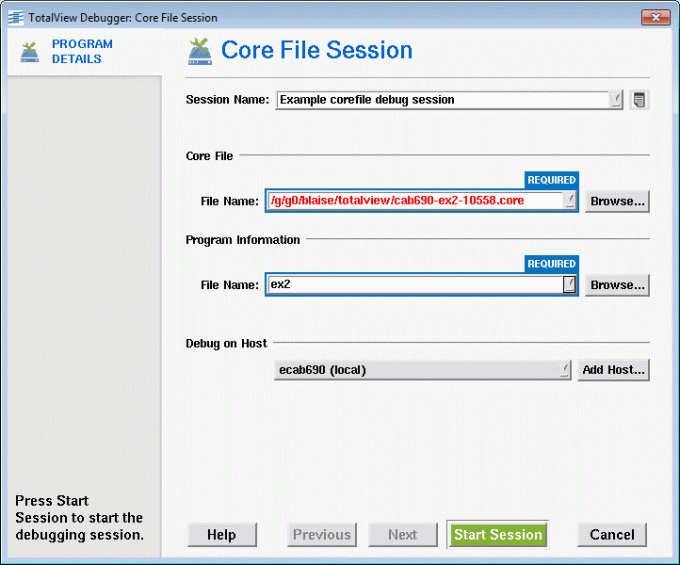
- Method 3:
- Start totalview from the command line without any arguments:
totalview
- The Session Manager window will appear. Select to debug A core file
- The Core File Session Dialog Box will appear as shown in Method 2 above.
- Continue as shown in Method 2 above.
Examine State
- After the core file has been loaded into the Process Window, you can examine the state (variables, stack, etc.) of the program when it crashed. You cannot run the program, per se, just examine the post-mortem dump.
- The program counter will usually point to the statement where the program crashed.
- An example of viewing a crashed program is provided below.
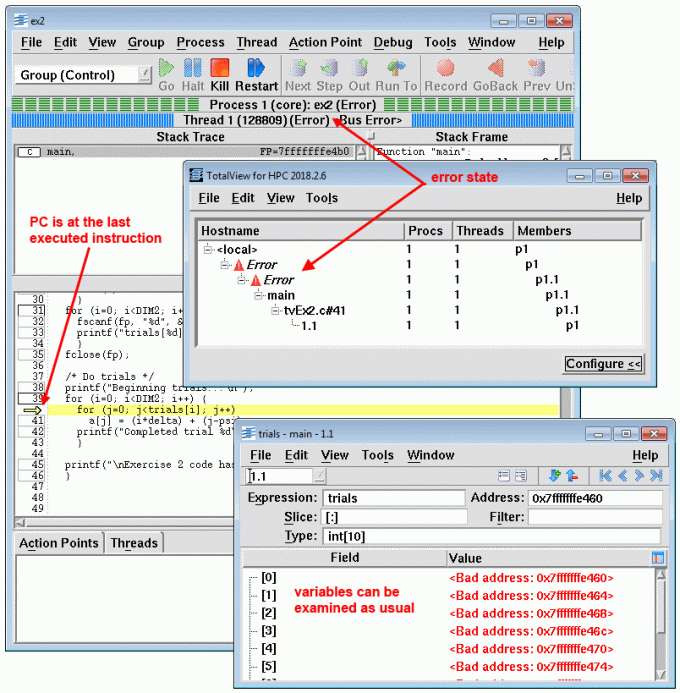
Core File Size
- It is quite likely that your shell's core file size setting may limit the size of a core file so that it is inadequate for debugging, especially with TotalView.
- To check your shell's limit settings, use either the limit (csh/tcsh) or ulimit -a (sh/ksh/bash) command. For example:
limit cputime unlimited filesize unlimited datasize unlimited stacksize unlimited coredumpsize 16 kbytes memoryuse unlimited vmemoryuse unlimited descriptors 1024 memorylocked 7168 kbytes maxproc 1024 ulimit -a address space limit (kbytes) (-M) unlimited core file size (blocks) (-c) 32 cpu time (seconds) (-t) unlimited data size (kbytes) (-d) unlimited file size (blocks) (-f) unlimited locks (-L) unlimited locked address space (kbytes) (-l) 7168 nofile (-n) 1024 nproc (-u) 1024 pipe buffer size (bytes) (-p) 4096 resident set size (kbytes) (-m) unlimited socket buffer size (bytes) (-b) 4096 stack size (kbytes) (-s) unlimited threads (-T) not supported process size (kbytes) (-v) unlimited
- To override your default core file size setting, use one of the following commands:
| csh/tcsh | unlimit -or- limit coredumpsize 64 |
|---|---|
| sh/ksh/bash | ulimit -c 64 |
Loading Executables
When to Use
- If you did not specify an executable when you started TotalView
- To load a new executable at any time during your debugging session
- To reload the same executable after recompiling
How to Load a New Executable
- Use either:
- PATH Root Window > File Menu > Debug New Program
- PATH Process Window > File Menu > Debug New Program
- The Program Session Dialog Box will appear (below). Enter the name of the executable in the box provided, and click OK. A Process Window containing the newly loaded process will then appear allowing you to debug as usual.

Reloading a Recompiled Executable
- If you make modifications to your source code and recompile it, TotalView will attempt to load the new source automatically the next time you load/run your program. If TotalView cannot find your modified source, you will have to load it yourself.
Expression Evaluation and Code Fragments
Code Fragments
- TotalView enables you to enter "code fragments" during a debugging session. Code fragments can include a mixture of:
- C, Fortran or Assembler language code (Note: assembler support is architecture dependent).
- TotalView built-in variables ($tid, $pid, $systid ... )
- TotalView built-in statements ($stop, $hold, $stopall ...)
- TotalView Built-in Variables and Statements are listed here. Note Current information can be found in the Totalview PDF, Appendix A
- Code fragments interact with your program, and are evaluated within its runtime context. They can therefore be used for a variety of purposes, such as:
- Setting conditional breakpoints
- Program patching - branching around code and/or adding new code
- Effecting conditional execution
- Displaying program data
- Modifying program data
- Code fragments can be entered by two methods, each serving a different purpose:
- Evaluate Window
- Evaluation Point (covered later)
- There are restrictions and limitations for code fragments. See the TotalView documentation for details.
Using the Evaluate Window
- Make sure that a process has run to a meaningful point, particularly if you intend to use variables that are part of your program.
- Open an Evaluate Window (shown below) as follows:
- PATH Process Window > Tools Menu > Evaluate
- In the Evaluate Window, select the language of choice (C, Fortran, Assembler) if needed.
- Enter your code fragment in the Expression box.
- Click on the Evaluate button. The expression will be evaluated, and its value will appear in the Result box. Note that the value that appears relates to the last expression in the code fragment, in this case "sum".
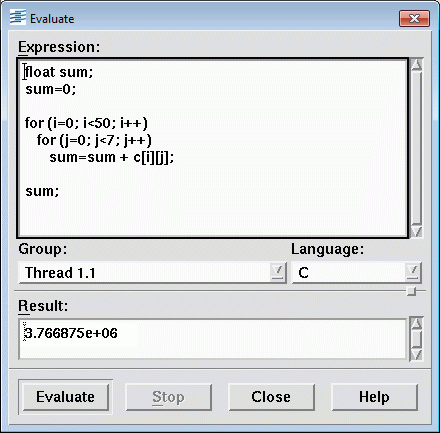
More on Action Points
Types of Action Points
- TotalView supports four different types of action points:
- Breakpoint: stops execution of the processes or threads that reach it.
- Barrier Point: holds each process when it reaches the barrier point until all processes in the group have reached the barrier point. Primarily for MPI programs.
- Evaluation Point: causes a code fragment to execute when it is reached. Enables you to set "conditional breakpoints" and perform conditional execution.
- Watchpoint: enables you to monitor a location in memory and either stop execution or evaluate an expression when the value stored in memory is modified.
Setting a Process Barrier Point
- After selecting a source line, there are three ways to set a barrier point:
- Method 1: (easiest) Right click on the source line and select Set Barrier from the resulting pop-up menu.
- Method 2:
- PATH Process Window > Action Point Menu > Set Barrier
- Method 3:
- PATH Process Window > Action Point Menu > Properties
- Then select the Barrier button in the resulting Action Point Properties Dialog Box (Barrier).
- The source line will then display a blue BARR icon as shown below.

- As each process reaches the barrier point, TotalView will place that process in a "held" state.
- After all processes have reached the barrier point, TotalView will automatically "release" them, however they remain stopped until you take further action.
- Note: As long a process is in a "held" state, it will ignore action commands as go, step, next, etc. You must first manually "release" it before attempting to resume execution. This can be done by selecting the Release command found in the Group, Process and Thread menus:
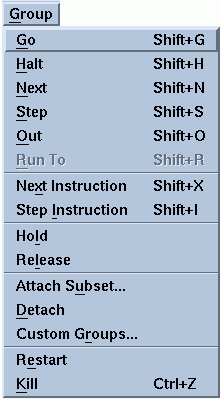
|

|
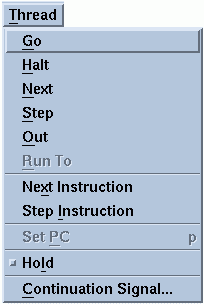
|
Setting an Evaluation Point
- First, make sure that the program is stopped.
- Open an Action Point Properties Dialog Box by either of these methods:
- Method 1: PATH Process Window > Action Point Menu > Properties
- Method 2: Right click on the source line and select Properties from the resulting pop-up menu.
- In the Action Point Properties Dialog Box, do the following:
- Click on the Evaluate button
- Select the button for the correct language if needed
- Enter your code fragment in the expression box - an example is shown below. (Expressions were covered previously under Expression Evaluation).
- Click on the OK button when finished.

Action point properties dialog box - The source line should now display an EVAL icon:

EVAL icon on source line - At runtime, the entered expression will be evaluated when it is encountered by a process or thread. Evaluation Point expressions are evaluated before the source code line.
Note Depending upon your platform, TotalView can either compile or interpret expressions, with the expected implications to performance. See the TotalView documentation for details.
Setting a Watchpoint
- You can monitor changes to specific memory locations by using a special kind of action point called a Data Watchpoint (or just Watchpoint for short).
- Watchpoints are most often used to find a statement in your program that is writing to a "stray" or unintended memory location.
- Watchpoints are triggered only when data in memory is modified. If a write occurs to a memory location but the value of the data is the same, the Watchpoint is not triggered.
- There are two types of watchpoints:
- Unconditional Watchpoint - program is automatically stopped by TotalView when the watchpoint is triggered.
- Conditional Watchpoint - allows you to specify an expression that is evaluated when the watchpoint is triggered.
- Note It is essential to consult the TotalView documentation before attempting to use watchpoints. There are numerous platform issues, restrictions and important details not mentioned here. For example, under Linux a watchpoint can't be larger than 4 bytes!
- To set either type of watchpoint:
- Dive on a variable to open a new Variable Window.
- Open a Watchpoint Properties Dialog Box: PATH Variable Window > Tools Menu > Create Watchpoint
- Note If watchpoints are not supported on your platform, this item will be "grayed out" and unable to be selected.
- A Watchpoint Properties Dialog Box will appear. Unconditional will be selected by default. For Conditional watchpoints you will need to enter a valid expression. Click the OK button when finished. An example of both types of watchpoint dialog boxes appears below.

- Conditional watchpoint expressions are identical to those used for Evaluation Points with some restrictions.
- Unlike other action points, watchpoints do not display an icon on a source line, because they are associated with an address location, not a source line number. Their presence is shown in the Action Points Pane however:

Deleting Action Points
- There are several ways to delete action points. Assuming that you have already selected a source line with an action point set:
- Method 1: Right click on the source code line and then select Delete from the resulting pop-up menu.
- Method 2: PATH Process Window > Action Point Menu > Delete
- Method 3: Open an Action Point Properties Dialog Box (Delete) (discussed earlier). Then select the Delete button.
- To clear all action points at once: PATH Process Window > Action Point Menu > Delete All
Disabling / Enabling Action Points
- Disabling an action point means that it is made "inactive" without deleting it. Enabling a previously disabled action point means that it is made active again.
- There are several ways to disable / enable an individual action point. Assuming that you have already selected source line with an action point set:
- Method 1: Right click on the source code line and then select Disable or Enable from the resulting pop-up menu.
- Method 2: PATH Process Window > Action Point Menu > Disable or Enable
- Method 3: Open an Action Point Properties Dialog Box (Enable) (discussed earlier). Then toggle the Enable action point button as desired.
- Method 4: Left click on the desired action point icon in the Process Window's Action Points Pane.
- To disable / enable all action points at once: PATH Process Window > Action Point Menu > Suppress All
- The Suppress All menu item will toggle between disabling (suppress) and enabling all action points.
- When an action point is disabled, it will appear as a dimmed icon in both the Action Points Pane and in the source code line, as shown below.


Saving / Loading Action Points
- You can have TotalView save all of your action points (except watchpoints) to a plain text file:
- PATH Process Window > Action Point Menu > Save All
- The filename for the action points file will be something similar to what's shown below (there is some variation in the actual naming format between different versions).
- executable_name.TVD.v3breakpoints
- You can also load previously saved action points into your current debugger session:
- PATH Process Window > Action Point Menu > Load All
Attaching / Detaching Processes
- TotalView can be used to debug programs or processes that are already running. This can be particularly useful for diagnosing "hung" programs.
- Typical scenario:
- Start a program
- Notice that the program is having problems
- Start TotalView
- Attach to the running process
- Fix or diagnose the problem
- Detach from process to resume execution - or else allow process to run to completion within TotalView
- Exit TotalView
How to Attach to a Process
- If possible, start totalview (no arguments) on the machine where your program is running. A Session Manager window should automatically appear with the usual Root Window.
- In the Session Manager window, select the A running program (attach). An Attach to running program(s) dialog box will appear as shown below.
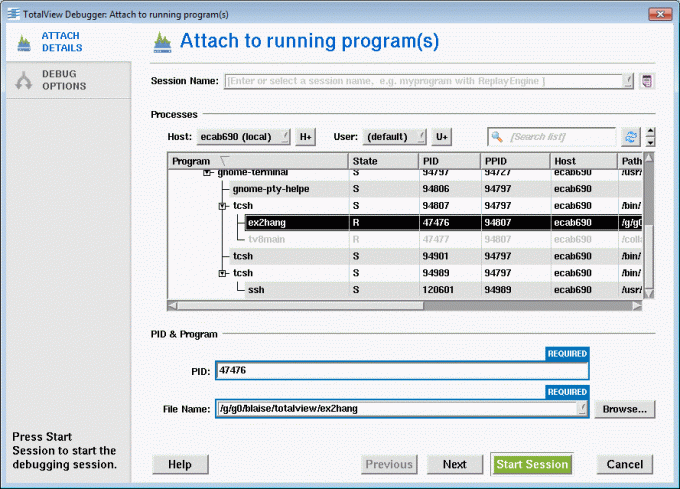
- Select the process of interest (such as your hung program) from the process list, then click the Start Session button.
- A new Process Window will appear, showing the state of the attached process and allowing you to debug it. In most cases, you will need to Halt the process before you can begin to debug it.
- Note that you are also able to attach to processes on other machines through the Host: H+ button.
Detaching from a Process
- When you are finished debugging an attached process, you can detach from it: PATH Process Window > Process Menu > Detach
- If you detach from a process that was not started by TotalView, it will remain in whatever state (i.e. running) it is in. TotalView will not automatically kill it.
- If your program has a signal handler, you can also have TotalView send a signal to the process when it detaches: PATH Process Window > Thread Menu > Continuation Signal
- A Continuation Signal Dialog Box will appear. Select the signal TotalView should send to the process when it detaches, such as SIGSTOP
Setting Executable Command Arguments
How to Pass Arguments to Your Program
- By default, TotalView does not pass arguments to a program being debugged.
- If your program requires command line arguments, they must be passed to the program through TotalView before your program starts.
- Method 1:
- Use the -a flag on the UNIX shell command line when you start the debugger with the totalview command. This must be the last argument in the command string. For example:
totalview a.out -a arg1 arg2 arg3
- Method 2: PATH Process Window > Process Menu > Startup Parameters
- When the Startup Parameters Dialog Box appears (below), make sure that the Arguments page is selected.
- Enter the arguments to be passed to your program when it starts. Separate arguments with spaces or put each on a new line. For single arguments with embedded spaces, enclose the entire argument with double quotes.
- Enter any environment variables if needed.
- Select OK when finished.
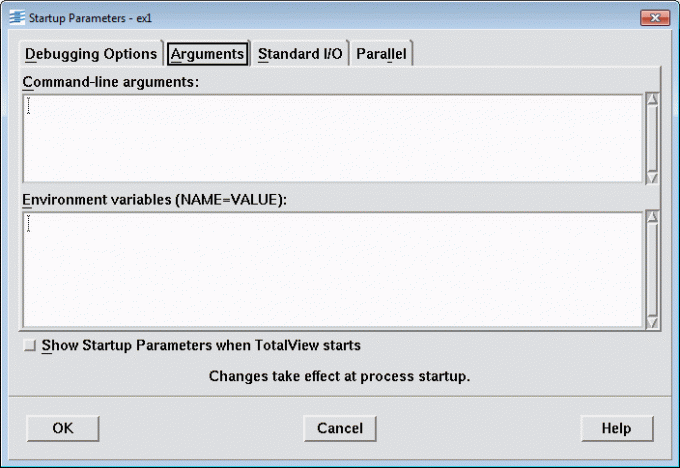
Setting Source Code Search Paths
Purpose
- In cases where your source code and executables are not co-located, you may need to tell TotalView where to search for the various components.
Default Behavior
- By default, the debugger will search the following directories (in order):
- Current working directory
- Path of an executable started with a full path name
- Directories specified in your PATH environment variable.
How to Add Additional Search Paths
- Select either:
- PATH Process Window > Process File Menu > Search Path
- PATH Root Window > Process File Menu > Search Path
- In the Search Path Dialog Box (shown below), click on the Sources tab and then enter the directories that should be searched, in order. They can be separated with a space or a new line. Relative path names are permitted (relative to the current working directory).
- To browse for directories to add, click on the Insert button to open a Select Directory Dialog Box.
- Note that these paths will be persistent from session to session.

Setting stdin, stdout, and stderr
Default Behavior
- By default, TotalView reads stdin from, and writes stdout/stderr to the shell window where you started the debugger.
- TotalView allows you to change the default behavior for each of stdin, stdout, and stderr.
To Change the Defaults
- PATH Process Window > Process Menu > Startup Parameters
- After the Startup Parameters Dialog Box appears be sure to select the Standard I/O Tab (below). Then enter file names and select from the available options as desired. Click OK when finished.
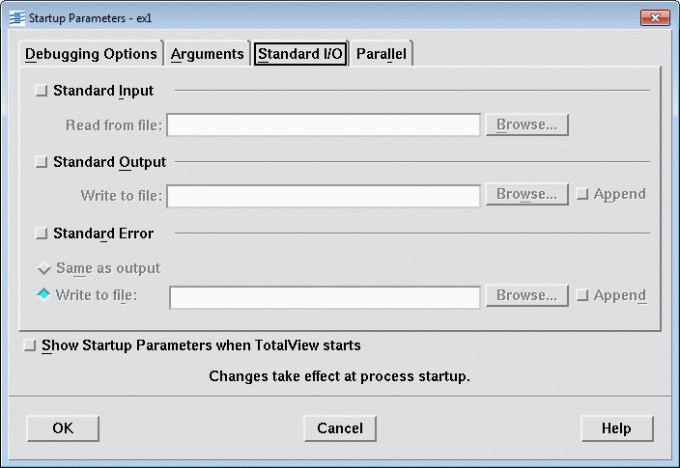
Signal Handling
Purpose
- If your program includes its own signal handler routine, you may need to modify TotalView's defaults.
How to Modify TotalView's Signal Handling
- To view or set the debugger's signal handling behavior: PATH Process Window > Process File Menu > Signals
- The Signal Handling Dialog Box will appear (below). Note that signal names, behaviors and numbers are platform specific.

- Select the desired mode (behavior) for any given signal. Signal handling modes choices are:
- Error - stops process, places it in an error state, and displays an error in the title bar of the process window.
- Stop - stops process and places it in the stopped state. Equivalent to SIGSTOP.
- Resend - debugger will send signal to the process. This mode should be used for all signals handled by your own signal handler routine.
- Ignore - discards the signal and restarts the process without a signal. Should not be used for fatal signals, as it may cause the debugger to get caught in a signal/resignal loop.
- Note TotalView uses the SIGTRAP and SIGSTOP signals internally. If either occurs, TotalView neither stops the process with an error or has the signal sent back to the program. This behavior cannot be changed.
- See the TotalView documentation for details.
Displaying Your Program's Call Graph
- TotalView's Call Graph Diagram can be used to show all of your program's active routines. These routines are linked by arrows indicating that one routine is called by another.
- The Call Graph Diagram is dynamic - the display reflects the current program state.
- To view the Call Graph Diagram: PATH Process Window > Tools Menu > Call Graph
- The ability to selectively display the call tree by process/thread group is provided by the drop-down menu at the top of the graph.
- The Update button tells TotalView to recreate this display for a new process/thread group, or to see how the call tree has changed as a result of running the program to another point.
- The Save As button allows you to save your graph in Graphiz .dot format.
- An example Call Graph Diagram is shown below.
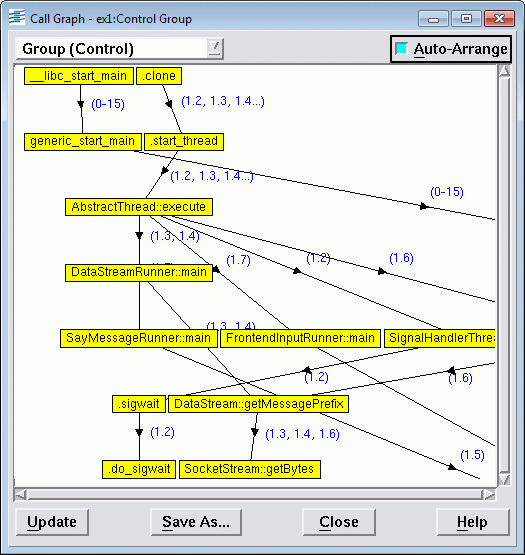
Debugging Memory Problems
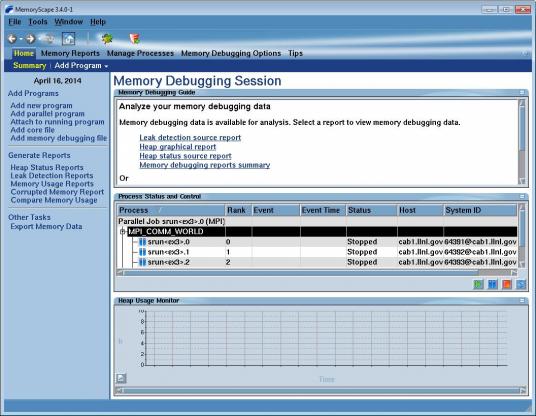
- TotalView includes full featured memory debugging functionality. This is packaged as a separate, but integrated, client called MemoryScape.
- Key features include:
- Memory usage reports
- Leak detection
- Heap status
- Corrupted memory detection
- Dangling pointer detection and pointer status
- Event and error notification
- Setting guard blocks
- Block painting
- Covering the many features included in MemoryScape would require a separate tutorial. Only a few very basics are covered here.
- For complete information, consult the MemoryScape documentation located at: www.roguewave.com/support/product-documentation/totalview.aspx.
Starting MemoryScape
- The MemoryScape executable, called memscape is located in the same directory as the totalview executable.
- Invoking MemoryScape directly - examples:
| Command | Description |
|---|---|
| memscape | Brings up the main MemoryScape window |
| memscape myprog | Opens MemoryScape with your program |
| memscape myprog -a arguments | Opens MemoryScape with your program and your program's arguments |
|
memscape myprog |
Opens MemoryScape with your program under the specified MemoryScape options |
| memscape srun -a -n8 -ppdebug myprog |
LC parallel job on a linux cluster: opens MemoryScape with srun, used to launch your parallel MPI program; uses 8 tasks in the pdebug pool. |
- Once MemoryScape starts up, you will be presented with the main opening window, which allows you to set options, execution, memory debugging, generation of memory reports and more. Click on the small image below for a larger image.

- Starting MemoryScape from within a TotalView session:
- Before your program starts to run, turn on memory debugging (it's usually set to off by default): PATH Process Window > Debug Menu > Enable Memory Debugging
- Run your program under TotalView as usual, to a stopping point. Then launch MemoryScape: PATH Process Window > Debug Menu > Open MemoryScape
- The MemoryScape main window should then appear as shown above.
Some Example MemoryScape Displays
Click on the small images for a larger image.
|
Image
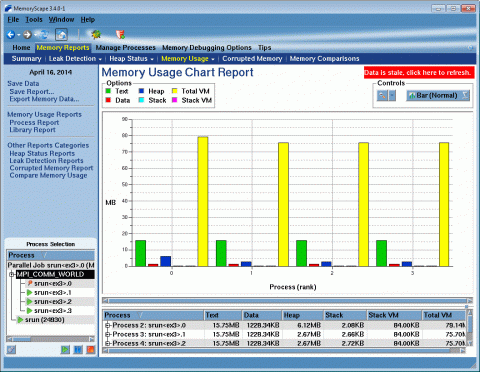
|
Image

|
|
Image

|
Image
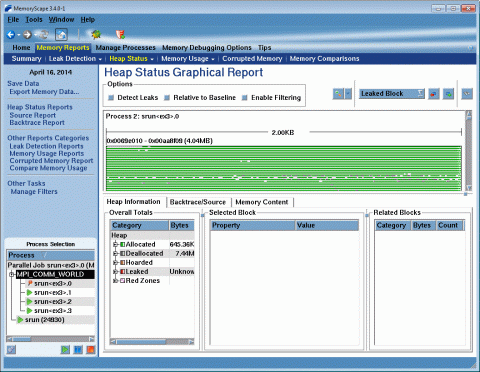
|
Setting Preferences
About Preferences
- Users can control many aspects of TotalView's appearance and behavior through setting Preferences.
- The Preferences Dialog Box is used to view and set preferences. It can be opened by using either of the paths below:
- PATH Process Window > Process File Menu > Preferences
- PATH Root Window > Process File Menu > Preferences
Preferences Dialog Box
- The Preferences Dialog Box (below) is comprised of multiple pages that serve to group preferences into general categories.
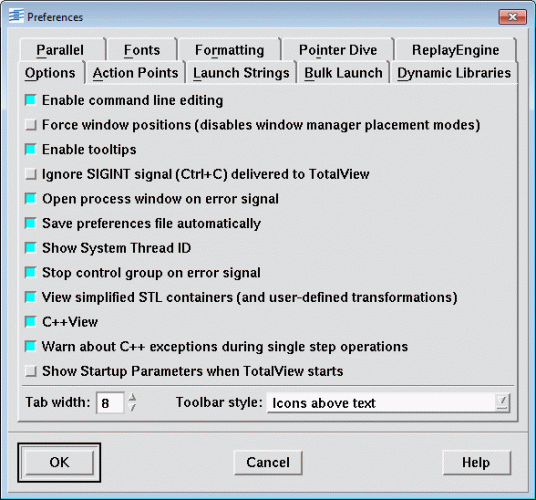
- Options: This page contains several options that are general or miscellaneous in nature (shown above).
- Action Points: The commands on this page indicate what else is stopped, if anything, when TotalView encounters an action point, the scope of the action point, automatic saving and loading, and if TotalView should open a Process Window for the process encountering a breakpoint.
- Launch Strings: The three areas of this page let you set the launch string when TotalView launches its remote debugging server, the Visualizer, and a source code editor. Notice that there are default values for these that are platform specific.
- Bulk Launch: This page allows you to change the bulk launch command, disable bulk launch, and alter connection timeouts used by TotalView when it launches the tvdsvr programs.
- Dynamic Libraries: This page lets you control which symbols are added to TotalView when it loads a dynamic library.
- Parallel: This page lets you define what will occur when your program goes parallel.
- Fonts: Use this page to specify the fonts used in the user interface and when TotalView displays your code and program data.
- Formatting: Allows you to specify how variables of different data types are displayed.
- Pointer Dive: Specifies when pointers are dereferenced in TotalView displays.
- Replay Engine: Specifies a couple options for TotalView's Replay Engine feature.
Visualizing Array Data
The TotalView Visualizer
- The TotalView Visualizer works with the debugger software to create graphical displays of your program's data. It is a self-contained process that can be launched from the debugger, or alone on the command line.
- The debugger is used to capture the data you select. The Visualizer is used to view the captured data.
- Data can be visualized while the debugger is running, or separately by reading the captured data from a file without the debugger.
- Types of data that can be visualized:
- One and two-dimensional arrays of integer or floating-point data.
- Arrays with greater than two dimensions can be visualized by using TotalView's array "slicing" feature to create arrays with one or two dimensions.
- Using the TotalView intrinsic $visualize, you can also visualize array variables from within an Evaluate Window or Evaluation Point. Some examples are shown below.
| C | Fortran |
|---|---|
| $visualize(matrixa) $visualize(matrixa,"[::2][10:15]") $visualize(matrixa,"[12][:]") |
$visualize(matrixb) $visualize(matrixb,'(11:16,::2)') $visualize(matrixb,'(:,12)') |
- Visualizer Animation: using $visualize within an evaluation point causes TotalView to update the array display every time TotalView reaches the evaluation point. This technique has the effect of producing an animation of the changing array data.
- For other Visualizer options and information, consult the TotalView documentation.
Getting Started

- Run your program in TotalView to a breakpoint where you know the array of interest will have relevant data.
- Dive on the array variable. A Variable Window will then open, showing the contents of the array.
- Select Visualize from the Variable Window's Tools Menu. Shown at right.
- The Dataset Window will then appear, as will a Graph View Window or Surface View Window of your array data (depending upon which view the visualizer thinks is best). Examples of all three windows are shown below.
Primary Visualizer Windows
- Dataset Window
- Shows the data sets that are available for visualization.
- View menu selects between graph and surface views.

- Surface View Window
- Left mouse click and then typing "p" or "P" on a plot area will display data value at that point.
- Dragging with left mouse button controls rotation of display.
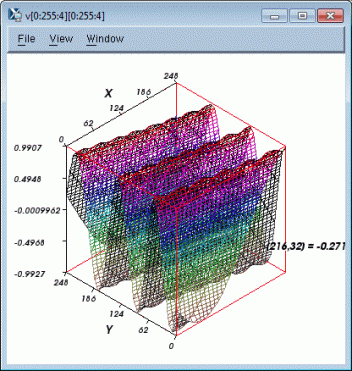
- Graph View Window
- Same data set as in the above surface view.
- Left mouse click and then typing "p" or "P" on a plot area will display data value at that point.
- File menu Options selection allows plotting as lines, points or both.
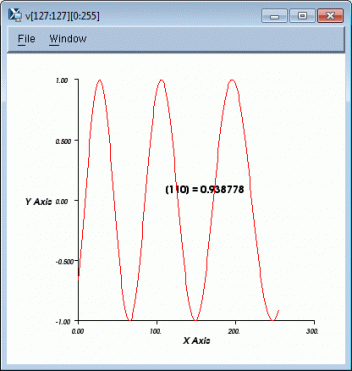
Command Line Interpreter (CLI)
- The TotalView Command Line Interpreter (CLI) provides a command line debugger interface. It can be launched either stand-alone or via the TotalView GUI debugger.
- The CLI consists of two primary components:
- The CLI commands
- A Tcl interpreter
- Because the CLI includes a Tcl interpreter, CLI commands can be integrated into user-written Tcl programs/scripts for "automated" debugging. Of course, putting the CLI to real use in this manner will require some expertise in Tcl.
- Most often, the TotalView GUI is the method of choice for debugging. However, the CLI may be the method of choice in those circumstances where using the GUI is impractical:
- When a program takes several days to execute.
- When the program must be run under a batch scheduling system or network conditions that inhibit GUI interaction.
- When network traffic between the executing program and the person debugging is not permitted or limits the use of the GUI.
- See the TotalView documentation for details:
Starting an Interactive CLI Debug Session
- Method 1: From within the TotalView GUI:
- Use either path:
- PATH Process Window > Tools Menu > Command Line
- PATH Root Window > Tools Menu > Command Line
- A TotalView CLI xterm window (below) will then open for you to enter CLI commands.
- Load/Start your executable or attach to a running process
- Issue CLI commands
- Use either path:
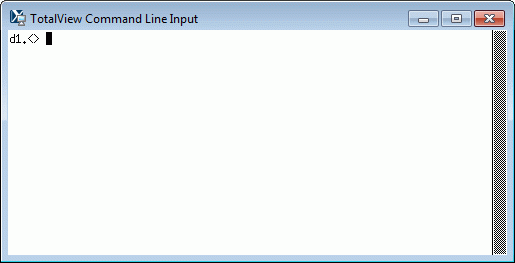
- Method 2: From a shell prompt window:
- Invoke the totalviewcli command (provided that it is in your path).
- Load/Start your executable or attach to a running process
- Issue CLI commands
CLI Commands
- As of TotalView version 8, there are approximately 60 CLI commands. These are covered completely in the TotalView Reference Guide.
- Some representative CLI commands are shown in the table below.
| Environment Commands | |
|---|---|
| alias | Creates or views user-defined commands. |
| capture | Allows commands that print information to instead send their output to a string variable |
| dgroups | Manipulates and manages groups |
| dset | Changes or views values of CLI state variables |
| dunset | Restores default settings of CLI state variables |
| help | Displays help information |
| stty | Sets terminal properties |
| unalias | Removes a previously defined command |
| dworker | Adds or removes a thread from a workers group |
| CLI Initialization and Termination | |
|---|---|
| dattach | Attaches to one or more processes currently executing in the normal run-time environment |
| ddetach | Detaches from processes |
| dkill | Kills existing user process, leaving debugging information in place |
| dload | Loads debugging information about the target program into TotalView and prepares it for execution |
| dreload | Reloads the current executable |
| drerun | Restarts a process |
| drun | Starts or restarts the execution of users processes under control of the CLI |
| dstatus | Shows current status of processes and threads |
| quit | Exits from the CLI, ending the debugging session |
| Program Information | |
|---|---|
| dassign | Changes the value of a scalar variable |
| dlist | Browses source code relative to a particular file, procedure or line |
| dmstat | Displays memory use information |
| dprint | Evaluates an expression or program variable and displays the resulting value |
| dptsets | Shows status of processes and threads |
| dwhat | Determines what a name refers to |
| dwhere | Prints information about the target thread's stack |
| Execution Control | |
|---|---|
| dcont | Continues execution of processes and waits for them |
| dfocus | Changes the set of process, threads, or groups upon which a CLI command acts |
| dgo | Resumes execution of processes (without blocking) |
| dhalt | Suspends execution of processes |
| dhold | Holds threads or processes |
| dnext | Executes statements, moving into subfunctions if required |
| dnexti | Executes machine instructions, stebbing over subfunctions |
| dout | Runs out from the current subroutine |
| dstep | Executes statements, moving into subfunctions if required |
| dstepi | Executes machine instructions, moving into subfunctions if required |
| dunhold | Releases a held process or thread |
| duntil | Runs the process until a target place is reached |
| dwait | Blocks command input until processes stop |
| Action Points | |
|---|---|
| dactions | Views information on action point definitions and their current status |
| dbarrier | Defines a process or thread barrier breakpoint |
| dbreak | Defines a breakpoint |
| ddelete | Deletes an action point |
| ddisable | Temporarily disables an action point |
| denable | Reenables an action point that has been disabled |
| dwatch | Defines a watchpoint |
| Miscellaneous | |
|---|---|
| dcache | Clears the remote library cache |
| ddown | Moves down the call stack |
| dflush | Unwinds stack from suspended computations |
| dlappend | Appends list elements to a TotalView variable |
| dup | Moves up the call stack |
Example Interactive TotalView CLI Debug Session
- This simple example demonstrates the interactive use of the TotalView CLI. The example program does nothing more than go into an infinite loop. The CLI commands are then used to "debug" it.
- CLI commands are in green text. Annotations/comments are in red text.
First, make sure the CLI is in our path % which totalviewcli /usr/local/bin/totalviewcli List the program. Note the bug. % cat spinhung.c /****************************************************************************** * FILE: spinhung.c * DESCRIPTION: * Simple example file * Compile: gcc -g spinhung.c -o spinhung * ****************************************************************************/ main() { int i, j, x; i=99; while (i < 100) { x = 2*i; j = i; } } Start the CLI % totalviewcli d1.<> Load the program d1.<> dload spinhung 1 d1.<> List the program d1.<> dlist 1 -n 20 1 /****************************************************************************** 2 * FILE: spinhung.c 3 * DESCRIPTION: 4 * Simple example file 5 * Compile: gcc -g spinhung.c -o spinhung 6 * 7 ****************************************************************************/ 8 9 main() { 10 11 int i, j, x; 12 13 i=99; 14 while (i < 100) { 15 x = 2*i; 16 j = i; 17 } 18 19 } Display CLI settings d1.<> dset BARRIER_STOP_ALL process BARRIER_STOP_WHEN_DONE group CGROUP(1) 1 COMMAND_EDITING false EXECUTABLE_PATH {} EXECUTABLE_SEARCH_MAPPINGS {} EXECUTABLE_SEARCH_PATH {${EXECUTABLE_PATH}:${PATH}:.} GROUP(1) {control 1} GROUP(2) workers GROUP(3) {share 1} GROUPS {1 2 3} LINES_PER_SCREEN AUTO MAX_LEVELS 512 MAX_LIST 20 OBJECT_SEARCH_MAPPINGS {} OBJECT_SEARCH_PATH {${COMPILATION_DIRECTORY}:${EXECUTABLE_PATH}:${EXECUTABLE_DIRECTORY}:$links(${EXECUTABLE_DIRECTORY}):.:${TOTALVIEW_SRC}} PROMPT {[dfocus]> } PTSET d1.< SGROUP(1) 3 SHARED_LIBRARY_SEARCH_MAPPINGS {} SHARED_LIBRARY_SEARCH_PATH {${EXECUTABLE_DIRECTORY}} SHARE_ACTION_POINT true SOURCE_SEARCH_MAPPINGS {} SOURCE_SEARCH_PATH {${COMPILATION_DIRECTORY}:${EXECUTABLE_PATH}:${EXECUTABLE_DIRECTORY}:$links(${EXECUTABLE_DIRECTORY}):.:${TOTALVIEW_SRC}} STOP_ALL process TAB_WIDTH 8 TOTALVIEW_ROOT_PATH /collab/usr/global/tools/totalview/r/toolworks/totalview.8.12.0-1/linux-x86-64 TOTALVIEW_TCLLIB_PATH /collab/usr/global/tools/totalview/r/toolworks/totalview.8.12.0-1/lib TOTALVIEW_VERSION {Linux x86_64 TotalView 8.12.0-1} VERBOSE error WGROUP(1) 2 Set a breakpoint at line 15 d1.<> dbreak 15 1 Start the program d1.<> drun Display process status d1.<>dstatus 1 (18902) Breakpoint [spinhung] 1.1 (18902/18902) Breakpoint PC=0x0040052b, [/g/g0/blaise/totalview/spinhung.c#15] List the program again - note the breakpoint on line 15 d1.<> dlist 1 -n 20 1 /****************************************************************************** 2 * FILE: spinhung.c 3 * DESCRIPTION: 4 * Simple example file 5 * Compile: cc -g spinhung.c -o spinhung 6 * 7 ****************************************************************************/ 8 9 main() { 10 11 int i, j, x; 12 13 i=99; 14 while (i < 100) { 15@> x = 2*i; 16 j = i; 17 } 18 19 } Display a variable value d1.<> dprint i i = 0x00000063 (99) Query about action points d1.<> dactions 1 shared action point for group 3: 1 [spinhung.c#15] Enabled Step through program d1.<> dstep 16 > j = i; d1.<> dstep 14 > while (i < 100) { Delete the breakpoint and then relist the program - note that breakpoint is gone. d1.<> ddelete 1 d1.<> dlist 1 -n 20 1 /****************************************************************************** 2 * FILE: spinhung.c 3 * DESCRIPTION: 4 * Simple example file 5 * Compile: cc -g spinhung.c -o spinhung 6 * 7 ****************************************************************************/ 8 9 main() { 10 11 int i, j, x; 12 13 i=99; 14 > while (i < 100) { 15 x = 2*i; 16 j = i; 17 } 18 19 } Resume execution and note where program is hung d1.<> dgo d1.<> dwhere > 0 main PC=0x00400523, FP=0x7fffffffdf20 [/g/g0/blaise/totalview/spinhung.c#14] 1 __libc_start_main PC=0x2aaaab186cd9, FP=0x7fffffffdfe0 [/lib64/libc.so.6] 2 _start PC=0x00400454, FP=0x7fffffffdff0 [/g/g0/blaise/totalview/spinhung] Halt the program and "fix" the bug d1.<> dhalt d1.<> dassign i 101 Resume execution and prove that the program exits to completion d1.<> dgo d1.<> dwhere dwhere: Focus thread was not found in process 1 Quit the CLI and return to the shell d1.<> quit Do you really wish to exit TotalView? y
This concludes TotalView Part 2. Where would you like to go now?
- Back to the top of Part 2
- Return to Part 1: The Very Basics
- Continue to Part 3: Debugging Parallel Programs
